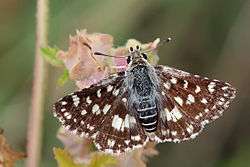Spread-winged skipper
Pyrginae, commonly known as spread-winged skippers, are a subfamily of the skipper butterfly family (Hesperiidae). The subfamily was established by Hermann Burmeister in 1878. Their delimitation and internal systematics has changed considerably in recent years, but as of 2009 the uncertainties surrounding the evolutionary relationships of many genera in this subfamily are widely resolved.[1]
| Spread-winged skippers | |
|---|---|
 | |
| Tapena thwaitesi (dry season form) from India (Tagiadini) | |
 | |
| Spialia mafa in the Ngorongoro Crater, Tanzania | |
| Scientific classification | |
| Kingdom: | Animalia |
| Phylum: | Arthropoda |
| Class: | Insecta |
| Order: | Lepidoptera |
| Family: | Hesperiidae |
| Subfamily: | Pyrginae Burmeister, 1878 |
| Diversity | |
| 7 tribes | |
It still is the second-largest subfamily of skipper butterflies, although of its over 1,000 species a considerable number are no longer in that classification.
Description and distribution


Spread-winged skippers bask with their wings held wide open. The wings are held closed when they are at rest. They are usually brown, black, or checkered, but some are brilliantly coloured. Some have long tailed hind wings.[2]
Males maintain territories and frequently perch on overhanging branches and tree trunks. They do not visit flowers for sustenance, but rather drink fluids from dung, carrion, and rotting fruit.[2]
A large and successful subfamily, the spread-winged skippers are found essentially worldwide, except in very cold or desert regions. They probably originated in the tropics and subsequently extended their range into more temperate regions. Perhaps, their place of origin is western Africa: most of the Celaenorrhini – one of the two basalmost tribes – are found in Africa, while the Carcharodini – the other very basal tribe – occurs throughout the tropics.
Most of the more advanced tribes, on the other hand, are very diverse in the Neotropics, which their ancestors would have found most easy to reach by crossing the central Atlantic, rather than taking the longer route via Europe and North America or the Pacific. It is also possible that the group originated in the Neotropics and subsequently dispersed eastwards to Africa via the Intertropical Convergence Zone.
Tribes
The formerly few tribes of Pyrginae have almost doubled in number. However, in its old delimitation the supposed "subfamily" was not monophyletic, and the former tribe Eudamini is now recognized as a distinct subfamily Eudaminae. The regent skipper (Euschemon rafflesia), at one time included in the pyrgine tribe Tagiadini, is actually the single most distinct living species of skipper butterflies, and warrants recognition in a subfamily of its own. On the other hand, the firetips – earlier treated as a subfamily of their own – have been found to be very close relatives of the Tagiadini and are now included in the Pyrginae as tribe Pyrrhopygini.[1]
The 7 tribes of the Pyrginae in their modern circumscription are, in phylogenetic sequence:
Footnotes
- Brower & Warren (2008)
- Daniels (2003): p.12
References
- Brower, Andrew V.Z. & Warren, Andrew (2008): Tree of Life Web Project – Pyrginae. Version of 2008-APR-07. Retrieved 2009-DEC-24.
- Daniels, Jaret C. (2003): Butterflies of the Carolinas. Adventure Publications, Inc., Cambridge, MN, USA. ISBN 1-59193-007-3.
Further reading
- Glassberg, Jeffrey Butterflies through Binoculars, The West (2001)
- Guppy, Crispin S. and Shepard, Jon H. Butterflies of British Columbia (2001)
- James, David G. and Nunnallee, David Life Histories of Cascadia Butterflies (2011)
- Pelham, Jonathan Catalogue of the Butterflies of the United States and Canada (2008)
- Pyle, Robert Michael The Butterflies of Cascadia (2002)
External links
| Wikimedia Commons has media related to Pyrginae. |